A wealth of culture, history, and breathtaking scenery can be found in Romania. It is well-known for its castles, the Dracula myth, and its stunning scenery. Here are some interesting facts to help you make the most of your visit before you explore this magical location. Every location has a unique tale, from the Carpathian Mountains to the imposing architecture of Bucharest.
You’ll be ready for an amazing adventure with these ten fascinating facts about Romania. You will discover the truth behind myths and witness the natural beauty and history of Romania. Together, let’s discover the delights of this European treasure.
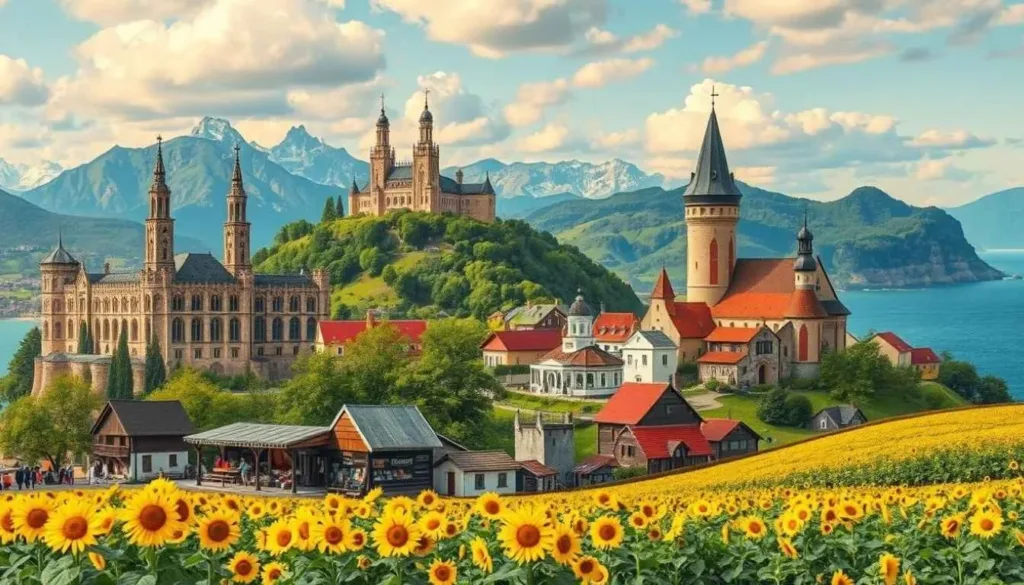
Key Takeaways
- Learn more about the rich history and customs of Romania.
- Learn about distinctive Romanian cultural features that add to the variety of Europe.
- Discover fascinating facts that highlight the architectural and natural beauty of one of the world’s most beautiful cities.
- Discover why Romania is more than its vampire myths by reading about it.
- Prepare yourself with information about Romanians to enhance the educational and pleasurable experience of your visit.
Exploring the Heart of Romania: Bucharest’s Rich History
The vibrant capital of Romania, Bucharest, is rich in culture and history. Both Bucharest’s Old Town and the Parliament’s magnificent Palace are located there. The city’s past and present are depicted in these locations, which blend history with daily living.
The Heaviest Building in the World: Palace of the Parliament
The heaviest structure in the world is the Palace of the Parliament. Romania’s communist period is strongly symbolized by it. With more than a thousand rooms, it was constructed during Nicolae Ceaușescu’s leadership. In Bucharest, you really must see it.
Bucharest’s Arch of Triumph: A Symbol of Victory
The first wooden version of the Arch of Triumph was created in 1922. It paid tribute to World War I Romanian soldiers. It later displayed Romania’s history and was composed of granite. Inspired by the Arc de Triomphe in Paris, it is located in the center of Bucharest.
The Old Town Charm: A Journey Through Centuries
Life and history abound in the ‘Lipscani’, or Old Town, of Bucharest. Its ancient structures and cobblestone streets narrate historical tales. Cafes, taverns, and stores abound now, fusing the past with the present.
| Landmark | Description | Significance |
|---|---|---|
| Palace of the Parliament | Largest administrative building | Symbol of communist era extravagance |
| Arch of Triumph | Remodeled in 1936 | Commemorates Romanian WWI victories |
| Bucharest Old Town | Historical and nightlife center | Reflects centuries of Romanian history |
Transylvania’s Mystical Charm: More than Vampire Legends
You may find more than vampire tales in Transylvania. The place has a rich history and breathtaking beauty. Nature, tradition, and history all converge here in a special way. In addition to vampires, it also touches on Romania’s enduring customs.
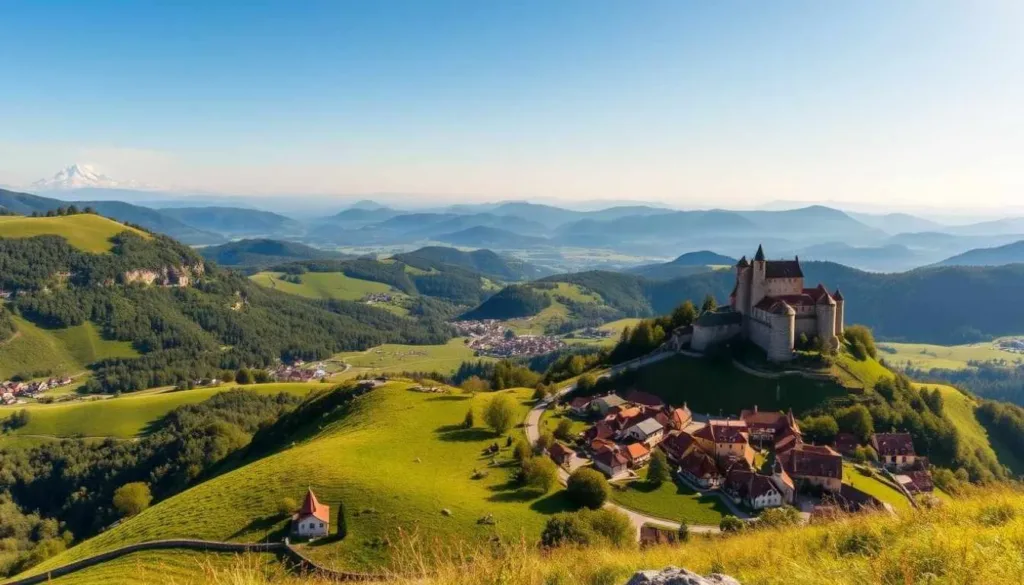
One of the highlights of Transylvania is the Scarisoara Glacier. Among Europe’s subterranean glaciers, it is the second largest. In addition to being large, this glacier has been protected. We can get a glimpse of the geological history of the area from it.
Another well-known feature of Transylvania is its castles and fortifications. These are not merely historic structures. They exhibit Romanian customs such as music and crafts, demonstrating their vibrant culture. Visitors can immerse themselves in a cultural and historical environment.
| Feature | Description |
|---|---|
| Scarisoara Glacier | One of the prime natural attractions in Transylvania, notable for being the second largest underground glacier in Europe, offering visitors a unique subterranean experience. |
| Medieval Castles | Historic sites that offer a glimpse into Transylvania’s past, often associated with the legend of Dracula, but rich in architectural and cultural significance. |
| Romanian Traditions | Cultural practices that include folk music, dances, and crafts, celebrated extensively in local festivals and fairs throughout Transylvania. |
Transylvania has a lot more to offer than vampire and Dracula myths. Because of its historical landmarks, customs, and scenic beauty, it is a very unique location. After their visit, visitors have a deeper respect for the heritage and beauty of Transylvania.
The Danube Delta: A Paradise of Biodiversity
Romania’s Danube Delta is a UNESCO World Heritage site and a hidden treasure. It is a veritable paradise, teeming with wildlife. One of the remaining untamed areas in Europe, this delta preserves the natural equilibrium of the land.
A Wonder of Nature: The Largest Reed Bed in the World
The largest reed bed in the world is found in the Danube Delta. Numerous species rely on it as a vital component of the ecosystem. These reeds filter the water, provide flood protection, and are essential for reproduction.
Birdwatching Haven: Unique Species in Their Natural Habitat
The Danube Delta is a birdwatcher’s paradise. More than 300 bird species call it home, including the Dalmatian Pelican. It’s a bustling spot for birdwatching.
It’s not simply birds that use the delta. There are several creatures and plants there, some of which are unique. Nature enthusiasts and scientists are drawn to it because of its beauty and richness. Protecting the area is a top priority for conservation.the future.
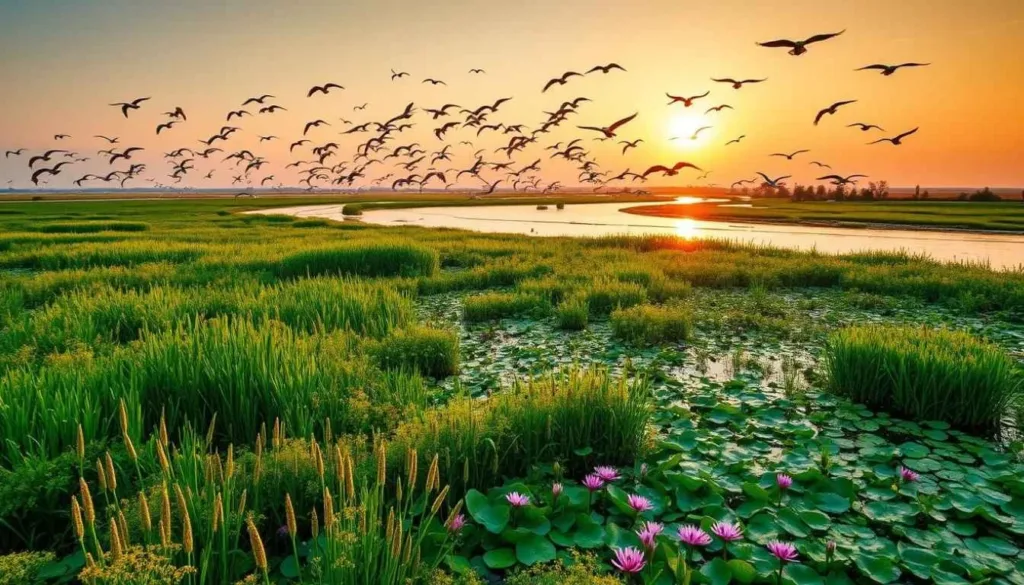
Natural Wonders: The Carpathian Mountains and Beyond
The Carpathian Mountains are one of Romania’s natural riches. They are vibrant and offer calm beauty. A prime example of Romania’s profusion of wildlife and vegetation, this area is well known for its natural beauty.
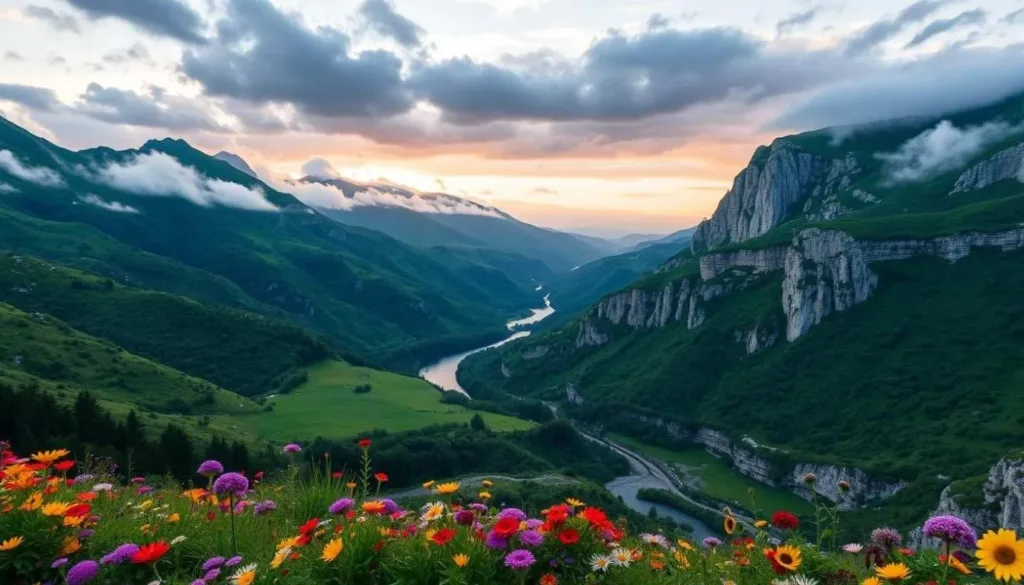
Romania is mostly covered by the Carpathians. The majority of Europe’s brown bear population resides there. This demonstrates the need for conservation and the abundance of wildlife in the area.
In the Carpathians, bears have a significant function. They contribute to the diversity and health of ecosystems.
- Hiking routes with panoramic views provide stunning views of Romania.
- Well-maintained ski resorts are ideal for winter sports.
- Visitors can get a closer look at one of Europe’s most fascinating biospheres at these wildlife viewing locations.
Outdoor enthusiasts will find heaven in Romania’s landscapes and way of life. Adventure is not the only reason to visit the Carpathians. They also teach us about the intricate systems found in nature.
Romania’s Living Heritage: Maramureș and Its Wooden Churches
Maramureș is a historical and culturally rich town in northern Romania. Several UNESCO World Heritage Sites and its well-known wooden churches serve as welcoming attractions for tourists. In addition to serving as spiritual centers, these churches showcase regional architecture and craftsmanship.
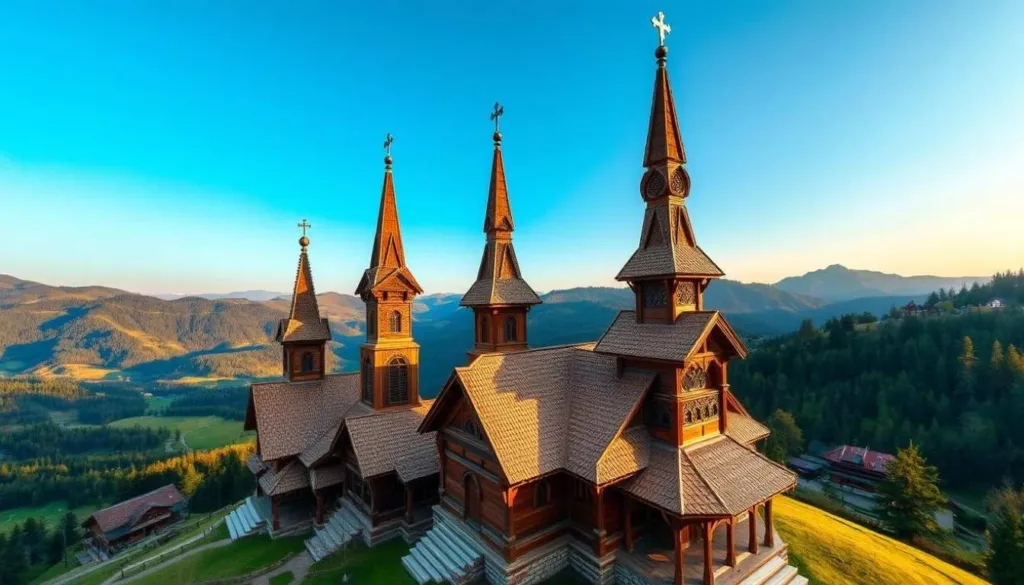
The distinctive architecture and intricate carvings of Maramureș’ wooden churches have earned them international renown. They have stood the test of time and are constructed from local oak. They blend very well with the northern Romanian countryside because to their tall, slender bodies.
Merry Cemetery: Where Death Meets Humor
There is nothing like the Merry Cemetery in Maramureș. It honors life with humorous sayings and vibrant gravestones. It provides insight into how the locals perceive life and death.
UNESCO World Heritage Sites: Preservation of Culture
Maramureș’s wooden churches are included as UNESCO World Heritage Sites. Their beauty and contribution to cultural preservation are praised. The history and customs of the area are narrated by each church.
For those interested in art, history, or peace, Maramureș is a unique destination. Romanian culture is deep, as evidenced by its wooden churches and Merry Cemetery. For this reason, Maramureș is an important location to comprehend the character of northern Romania.
The Compelling Legacy of Dacia: Romania’s Ancient Roots
Dacia is more than just an ancient place name. Romania has been profoundly impacted by the blending of cultures and history. A complicated civilization, the Dacians were renowned for their spiritual beliefs and bravery. Romanian culture is still influenced by these ideas.
The Enigmatic Dacians: Warriors and their Sanctuaries
The Dacians were renowned for their combat prowess and power. They engaged in fierce combat with the Roman Empire. Many people are interested in their temples and sanctuaries, which demonstrate their rich spiritual life.
Roman and Dacian Confluence: Language and Architecture
The Dacian civilization was assimilated by the Romans after they overran Dacia in AD 106. The local architecture and language were altered by this blending. Today’s Romanian is a mix of Dacian and Roman languages. Romanian buildings also exhibit this blending of Dacian and Roman architectural styles.
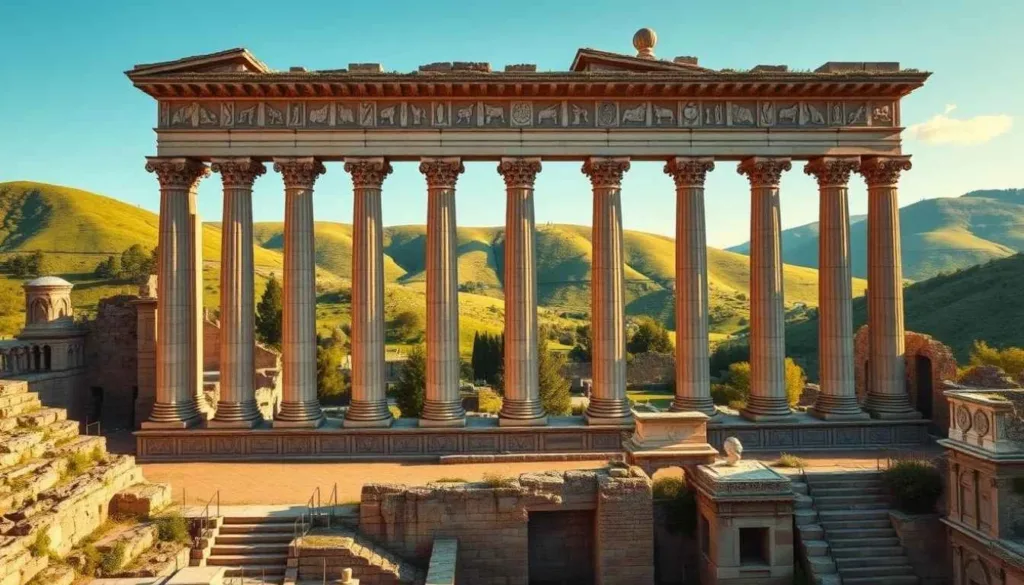
We can observe how Romanian culture was influenced by the Dacians and Romans by looking into Dacia’s past. We can better comprehend Romania’s past by preserving these antiquated customs. With its influence on Romanian language and architecture, the Dacian narrative is more than just ancient history.
| Aspect | Dacian Influence | Roman Influence |
|---|---|---|
| Language | Limited direct contributions | Formative basis of Romanian as a Romance language |
| Architecture | Fortifications and sanctuaries | Urban planning, roads, aqueducts |
| Religion | Gods like Zalmoxis | Integration of Roman gods, development of early Christian communities |
| Military Tactics | Guerrilla warfare, fortress defense | Organized Legion strategies, extensive military infrastructure |
Timișoara: The First European City with Electric Street Lights
In the rich history of Romania, Timișoara, located in the southwest, is renowned for a significant accomplishment. It was the first city in Europe to have street lights powered by electricity. This shows the city’s forward-thinking and marks a big chapter in urban life in Europe.
Timișoara made significant progress toward modernity on November 12, 1884. Approximately 731 electric street lamps illuminated the city. In the history of urban technology, this occurrence was significant.
| Year | Event | Significance |
|---|---|---|
| 1884 | Installation of electric street lights in Timișoara | First in Europe, symbolizing the onset of the technological age in urban development |
| 1889 | Paris lights up the Eiffel Tower with electricity during the World Fair | Highlighting the spread of electric light technology in major European cities after Timișoara |
| 1890 | London installs electric streetlights | Further adoption of electric lighting in major Western European capitals following Timișoara’s example |
Other technological and cultural advancements have continued to be influenced by Timișoara’s innovative mentality. As a result, the city has become a symbol of innovation in Romania’s southwest. Timișoara’s blend of modernity and heritage now attracts both tech enthusiasts and visitors. They visit to witness both its contemporary marvels and its rich past.
Fascinating Fossils and Prehistoric Marvels in Romania
Geological and historical treasures abound in Romania. It keeps making astounding discoveries that shed light on its rich history. Some of the most important discoveries in the world can be found there, ranging from the prehistoric period to the Dacian culture.
Oldest Cave Drawings on the Continent Found in Romania
Romania is home to the oldest cave drawings in Europe. They demonstrate the need for expression and communication in early humans. These works of art are thousands of years old and full with meaningful imagery.
55-Meter Tall Rock Sculpture: The Pride of the Danube
Decebalus, a 55-meter-tall rock sculpture cut into a cliff overlooking the Danube River, is a contemporary homage to Romania’s historic warriors. It displays the creativity and artistic talent of today’s sculptors. This figure brings history to life with his majestic presence.
The Danube valley in Romania is home to several fossil sites, including human fossils. Understanding the evolution of ourselves and our ancestors is made easier by these discoveries.
The history of Romania is a blank canvas just waiting to be discovered. From prehistoric caverns containing early human art to ancient Dacians, every fossil and item has a story to tell. They demonstrate how our forefathers adapted to this environment and prospered.
It is both fascinating and educational to explore these historical wonders. Through it, we are able to connect with the individuals and periods that shaped contemporary civilization.
The Unique Romanian Language: A Blend of History and Romance
Romanian is a vibrant mash-up of words and European history. It demonstrates the area’s rich language heritage and strong Roman roots. Slavic and other languages are mixed with Latin in Romanian, the only Romance language in Eastern Europe. This section delves deeply into Romanian’s history, demonstrating how it maintained its Latin foundation while gradually incorporating new vocabulary.
Romanian is a fascinating story that demonstrates the evolution of languages. The Latin used by the Roman conquerors was the first. Then, as a result of European political upheavals, migrations, and conquests, it underwent several modifications.
- Latin is the foundation of Romanian, including its grammar and lexicon. Because of this, it differs from Slavic languages.
- Words from Greek, Slavic, Turkish, and Hungarian were also incorporated. This demonstrates an intricate past of communication and exchange.
- Romanian now serves as a bridge between Eastern and Western Europe. It is also the area’s live history.
Keeping Romanian alive is crucial for education and culture today. It demonstrates the identity and legacy of the country. The key to understanding Romanian is its Roman heritage. They narrate a people’s history and enduring character.
Fun Facts About Romania: Discovering the Quirky and the Spectacular
It is in Romania that legend and history converge. It’s packed with fascinating facts and unusual views. From the tales of Dracula to the incredible achievements of Romanian gymnasts, there’s always something new to discover.
The Legend of Dracula: Romania’s Global Folklore Icon
A significant component of Romania’s allure is the Dracula mythology. It has made Bran Castle famous all over the world and is based on Vlad the Impaler. This tale, which attracts visitors from all around, blends myth with the rich history of Transylvania.
Nadia Comăneci: The Perfect Score in Gymnastics
Romania’s Nadia Comăneci is a renowned gymnast. At the 1976 Olympics in Montreal, she achieved the first-ever perfect score of ten, making history. Her accomplishment made Romania famous and motivated many gymnasts.
The Flora and Fauna: A Wealth of Wild Beauty Awaiting Exploration
There are numerous plants and animals in Romania’s wide natural area. It is a crucial European ecological region. From the Danube Delta to the Carpathian woodlands, it provides an opportunity to witness some of Europe’s most exquisite flora and fauna.
| Region | Notable Species | Conservation Status |
|---|---|---|
| Carpathian Mountains | Brown Bears, Wolves | Protected |
| Danube Delta | Pelicans, Cormorants | UNESCO Heritage Site |
| Transylvanian Alps | Lynx, Chamois | Conservation Efforts Ongoing |
Conclusion
When we traveled through Romania, we discovered a nation rich in history and distinctive cultural experiences. Highlights include the mystique of Transylvania, the animals of the Danube Delta, and the history of Bucharest. Romanians are renowned for their friendliness, and their monuments and customs showcase their rich history.
We were captivated by Romania’s natural splendor, from Maramureș to the Carpathian Mountains. Every location contributes to the rich culture of Romania by telling a tale. Because of its distinctive experiences, this nation is a popular choice for inquisitive tourists.
Exploring Romania entails immersing oneself in a culture that has endured. It combines elements of the past and present. Romania is a must-see whether you’re interested in ancient Dacia, Timișoara’s ingenuity, or Nadia Comăneci’s feat. It promises unforgettable experiences for those who explore its wonders.
FAQ
What interesting information exist about Romania?
Europe’s second largest subsurface glacier is located in Romania. Additionally, it is home to the greatest number of brown bears in Europe. Because of its Latin roots, Romanian is a Romance language.
One oddity is that the funny epitaphs in Maramureș’ Merry Cemetery are well-known.
Why is the Palace of the Parliament in Bucharest special?
The heaviest structure in the world is the Palace of the Parliament in Bucharest. A magnificent specimen of Romanian architecture, it is. This enormous building serves as a major administrative center.
Construction started during Nicolae Ceaușescu’s rule.
Is Transylvania just about vampire legends?
There is more to Transylvania than just Dracula mythology. It boasts old castles, beautiful scenery, and a wealth of Romanian customs. The Scarisoara Glacier, a striking natural beauty, is also located there.
Why is the Danube Delta important?
One of the UNESCO World Heritage sites is the Danube Delta. The world’s largest reed bed is this one. A wide variety of fauna can be found there.
It’s a great place to see birds and discover unusual plants and animals.
What can visitors expect in the Carpathian Mountains?
There are breathtaking vistas of the Carpathian Mountains. They offer chances for skiing and hiking. Additionally, a variety of wildlife, including brown bears, can be seen by visitors.
Why are Maramureș and its wooden churches significant?
The wooden churches of Maramureș in northern Romania are renowned. Numerous churches are included as UNESCO World Heritage monuments. Through their lively customs and expert craftsmanship, they highlight Romanian cultural treasures.
What is the legacy of ancient Dacia in modern Romania?
The influence of the Dacians’ military culture and sanctuaries can be seen in modern-day Romania. Romanian language and architecture are clear examples of the blending of Roman and Dacian cultures.
How did Timișoara make history with street lighting?
Timișoara was the first European city to use electric street lighting. As a result, it became a leader in urban growth during the industrial era.
What prehistoric discoveries can be found in Romania?
Some of the oldest cave drawings in Europe can be seen in Romania. King Decebalus’ 55-meter-tall rock sculpture on the Danube is also located there. Dacian human remains and fossils have been discovered all throughout the nation.
How does the Romanian language reflect the country’s history?
The Romance language that is Romanian has Latin roots. It displays the historical and cultural influences of many colonists, especially the Romans. Because of its linguistic background, it is unique among Eastern European languages.
What achievements are associated with the Romanian gymnast Nadia Comăneci?
The first-ever perfect 10 in Olympic gymnastics history was achieved by Romanian gymnast Nadia Comăneci, who is well-known for her accomplishment. This happened during the 1976 Summer Olympics in Montreal, which redefined sports excellence.



